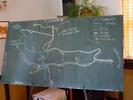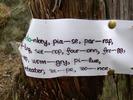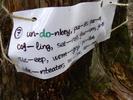The Spring School 2004 Bojovka Game - Ciphers and Solutions
 On Saturday afternoon, there was an adventure cipher game called Bojovka. 10 messages were
located in the surroundings of Vysoka Lipa (as shown in the map on the blackboard).
The goal was to find all messages and obtain a password. But all the messages were slightly enciphered, so
a bit of deciphering work was neccessary.
On Saturday afternoon, there was an adventure cipher game called Bojovka. 10 messages were
located in the surroundings of Vysoka Lipa (as shown in the map on the blackboard).
The goal was to find all messages and obtain a password. But all the messages were slightly enciphered, so
a bit of deciphering work was neccessary.
Here we give you the list of all ciphers and their solutions.


1. The top of the Šaunštejn rock castle
Here the message was encoded by notes, the notes had only two possible lengths. If you change each short
note to a dot and each long note to a dash, you obtain a text in the Morse code, one letter per each measure.
After translating the text from the Morse code, you get DO NOT GO TO PUB.

2. The ruins of the old mill
The idea was very simple – just find the perfect matching. The matching gives you translation
between numbers and letters, which you apply on the text above. The result is
APPARENTLY WONDERFUL.

3. A small wooden shed on the right side of the yellow path
The hint above tells you to use the computer keyboard and move right or left. Indeed, each letter
should be replaced by one of its horizontal neighbours on the keyboard (randomly chosen). You get the
slightly ironical text
RANDOM WALKS ARE NOT THE BEST WAY YO EXPLORE THE AREA.

4. Logs
The hexadecimal numbers here encode sets of segments of a seven segment display. After rewriting the
numbers in their binary form, each digit stands for one segment; one means on and zero means off. The hint
gives you several bit combinations and the corresponding results on the display so that you can match
the bits and segments. The resulting message is KNIGHTS ARE NOWADAYS VERY SPORADIC.

5. A tree on the right side of the path
This one was thought to be the worst one although it was quite easy if you got the idea.
We must admit that the hint was quite confusing; it should mean "the thick tree is bad, the thin one
is good", so you should find the minimum spanning tree, where the letters expressed edge weights.
The resulting spanning tree was a path, and after reading the letters along this path, you got
SEARCH FOR THE RIGHT TRICK.

6. Cemetery fence
Each tree encodes one binary number. A branch to the left means zero, a brach to the right is one.
The lowest bit is at the bottom. The number obtained encodes a letter, where the value of the number
is the order of the letter in the English alphabet.
The message is IMAGINE A FLY TRAPPED IN THE WORLD WIDE WEB.


7. A tree stem on Ptačí kámen
Here you should fill in groups of letters such that each group makes an English
word together with both the letter group on the left and on the right. The completions are: un-DO-nkey,
pia-NO-se, par-T-rap, cof-FEE-ling, see-D-rop, four-TH-orn, fre-E-gg, sic-K-eep, wom-AN-gry, pi-G-lue,
ide-A-nteater, ze-RO-pe, zo-O-nce. Reading only the letters filled in: DO NOT FEED THE KANGAROO.

8. A hole under a bridge on the road to Vysoka Lipa
One can observe that there are only four cubes drawn from several perspectives. Thus you could
reconstruct the whole cubes. Each one encoded one letter, it was the one on the bottom of the cube
(i.e. the one that the cube was lying on). The message is ESCAPE IF YOU SEE AN ANGRY KOALA.

9. A tree in a small valley
This was maybe the trickiest one. Even a bit more tricky because of several errors we made when
copying the cipher on the slide. But, fortunately, it was still solvable.
The hint tells you that each top-level pair of parenteses encodes one number. It is not very difficult
to guess that it has something in common with prime factors, but the question was, what.
Inside the top-level pair of parentheses, there is a sequence of prime indices (from right to left).
Each index is expressed recursively using the same method. The resulting message is OH HOW NICE IS TODAY'S WEATHER.

10. A wooden pole in the SW corner of a meadow
A program for a plotter - move the pen according to the arrows, the black arrow makes a line, the
green one does not. A square means the end of a word. The message is FEED THE TOAD AT THE ROAD.
Having done the deciphering, you had ten sentences, but together they made no sense neither
told you what the password is. So there was another puzzle to be solved. If you read all the first letters
of the sentences, then all the last ones, you get
DARK SIDE OF BLACKBOARD, which is not yet the final password. By looking on the rear side of the
blackboard, you discovered the 11th cipher:

11. The rear side of the blackboard
This one looked pretty difficult, and so it was. The key observation was that when calculating 1/23 by
hand, you obtain a sequence of remainders - integers between 1 and 22, which is the number of letters in
the cipher. The remainder sequence gives you a permutation of numbers which, when applied to the letters,
gives you the final password: ANY QUESTIONS OR COMMENTS?
We do have some comments:
Thank you all for participating, making such an effort in solving, collecting the ciphers after
the game and morever... for
not throwing us into the pond :-)
Your organizing team
 On Saturday afternoon, there was an adventure cipher game called Bojovka. 10 messages were
located in the surroundings of Vysoka Lipa (as shown in the map on the blackboard).
The goal was to find all messages and obtain a password. But all the messages were slightly enciphered, so
a bit of deciphering work was neccessary.
On Saturday afternoon, there was an adventure cipher game called Bojovka. 10 messages were
located in the surroundings of Vysoka Lipa (as shown in the map on the blackboard).
The goal was to find all messages and obtain a password. But all the messages were slightly enciphered, so
a bit of deciphering work was neccessary.












